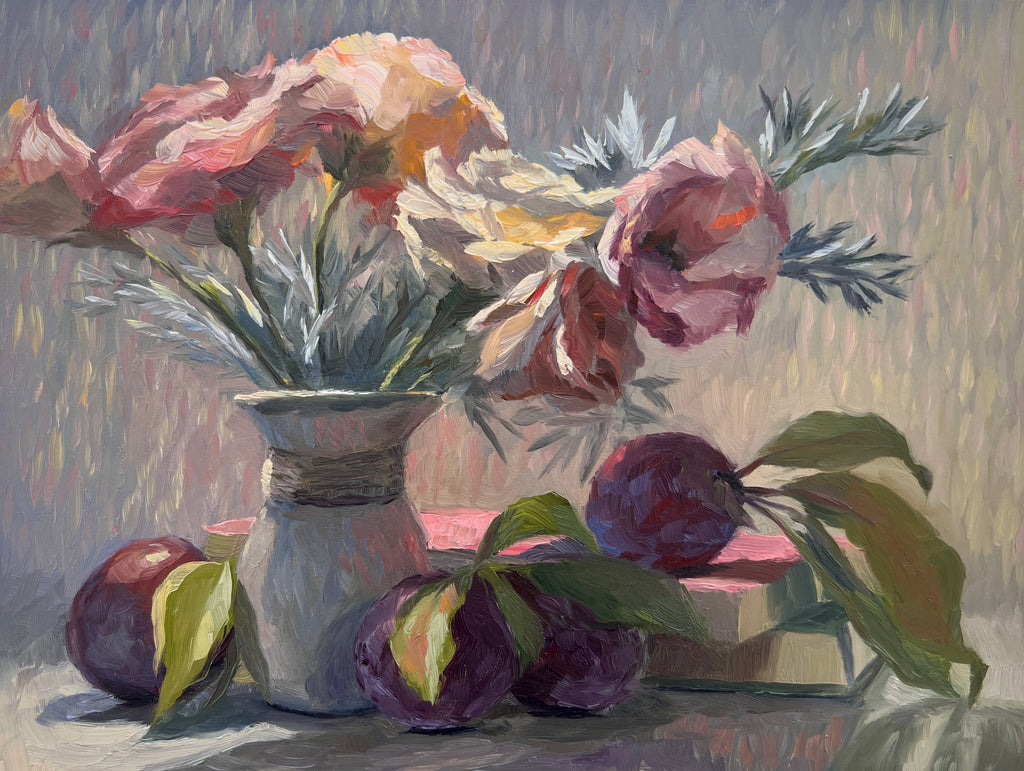Premium Gallery Quality Oil Paintings for Sale Now
Premium Gallery Quality Oil Paintings for Sale Now
Blog Article
Discovering Everything About Oil Paints: An Overview to Understanding Their Appeal and Worth
Oil paints have captivated target markets for centuries, using a glance right into the artistic mastery of various ages. Their abundant history is intertwined with ingenious strategies and extensive emotional expression. Comprehending the products and approaches behind these art work can enhance gratitude. Additionally, the marketplace for oil paints offers opportunities for collectors and financiers alike. As one explores this interesting world, the concern emerges: what makes an oil painting truly valuable?
The History of Oil Painting: A Trip With Time
Although oil paint has origins that date back to old times, it truly flourished throughout the Renaissance, when artists uncovered its versatility and abundant color possibility. Early instances can be traced to the 7th century, with methods advancing significantly across cultures. The medium came to be famous in Northern Europe in the 15th century, specifically via the works of artists like Jan van Eyck, who originated its use for thorough realism and dynamic tones. This period noted a separation from tempera paints, enabling better depth and appearance. As oil painting spread, it affected numerous artists, causing masterpieces by prominent figures such as Leonardo da Vinci and Rembrandt. The tool's legacy continues, forming the art globe well into modern-day times.
Understanding Oil Repaints: Materials and Techniques
As artists discover the globe of oil paints, they run into a diverse selection of materials and techniques that define this tool. The main elements of oil paint include pigments, which supply shade, and drying out oils, such as linseed, that bind the pigments and help with application. Various ingredients can modify the paint's texture and drying time, improving adaptability. Methods like glazing, where transparent layers are developed, and impasto, which involves applying thick paint, enable various visual results. Furthermore, the usage of brushes, scheme blades, and even fingers can produce one-of-a-kind appearances and coatings. Comprehending these methods and products enables musicians to completely share their imagination and accomplish the desired influence in their art work.
The Function of Color in Oil Paintings
Color plays a pivotal function in oil paints, affecting both aesthetic appeal and psychological resonance. Understanding shade concept basics, including the partnerships in between colors, can improve an artist's ability to share mood and atmosphere. In addition, mastering color blending strategies permits greater deepness and splendor in a painting's combination.

Color Concept Basics
Understanding color theory is vital for artists dealing with oil paints, as it creates the foundation for creating harmonious and visually engaging compositions. Shade concept includes the research of exactly how shades engage, the color wheel, and the partnerships in between main, secondary, and tertiary colors. Artists make use of complementary shades to improve contrasts and develop prime focus, while comparable colors promote unity and cohesiveness within a piece. Additionally, the concepts of trendy and warm shades affect the assumption of deepness and space in a paint. Comprehending these principles allows musicians to control shade successfully, leading the viewer's eye and interacting their designated message. Proficiency of color concept ultimately improves a musician's ability to share feelings and ideas through their job.
Emotional Effect of Color
The emotional influence of color in oil paints plays an essential function in how viewers view and connect with artwork. Colors evoke details feelings and state of minds, influencing the audience's emotion. Cozy shades like oranges and reds can produce a feeling of heat and energy, while amazing tones such as blues and environment-friendlies often evoke peace or introspection. Artists purposefully select color schemes to improve narrative elements, assisting the audience's psychological trip. The saturation and contrast of colors further enhance these effects, attracting focus and creating focus. Ultimately, the interplay of colors in oil paints not only enhances their visual appeal yet additionally acts as an effective tool for emotional expression, enriching the customer's experience and analysis.
Shade Mixing Techniques
While lots of elements of oil painting add to the general composition, grasping color mixing techniques is crucial for attaining preferred results and deepness. Color blending can be come close to with different approaches, including the additive and subtractive procedures. Additive mixing entails incorporating colors of light, while subtractive mixing depends on pigments, where shades mix to produce brand-new shades. Artists frequently use a limited palette to create unified jobs, recognizing the relationships in between main, secondary, and tertiary shades. Methods such as glazing and scumbling further boost deepness and luminosity. By skillfully blending shades, an artist can evoke emotions, develop prime focus, and achieve a feeling of realism, ultimately raising the paint's visual and emotional impact.
Famous Oil Painters and Their Iconic Works

Famed for their proficiency of color and technique, oil painters have actually created several of the most renowned artworks in history. Renowned artists like Vincent van Gogh captivated target markets with his emotive brushwork in "Starry Night," while Claude Monet's "Impression, Sunrise" laid the groundwork for Impressionism. Leonardo da Vinci's "Mona Lisa" remains a long-lasting symbol of artistic genius, showcasing his skill in catching human expression. At the same time, Rembrandt's "The Night Watch" illustrates his ingenious use of light and darkness. Other noteworthy figures consist of Pablo Picasso, who transformed modern art with his strong experimentation in works like "Les Demoiselles d'Avignon," and Georgia O'Keeffe, whose vivid representations of blossoms and landscapes assisted define American innovation. Each musician's special style contributed significantly to the oil painting landscape.
How to Examine the Quality of an Oil Paint
Assessing the quality of an oil paint includes a cautious assessment of craftsmanship strategies, along with an evaluation of shade and structure. Observing brushwork, layering, and the application of paint can disclose the musician's ability degree. In addition, the interplay of colors and the overall setup of aspects contribute considerably to the paint's visual value.
Examining Craftsmanship Techniques
A thorough analysis of craftsmanship methods is important for establishing the quality of an oil painting. Critics must first analyze the application of paint; thick, textured brushstrokes might suggest a skilled hand, while extremely consistent applications could indicate an absence of depth. oil paintings for sale. The layering method is also important; the visibility of glazes and differed thickness can boost brightness and complexity. Additionally, the quality of the click here materials made use of, such as the canvas and pigments, plays a considerable function in longevity and total visual. Interest to information in elements like sides and shifts in between colors mirrors the artist's dedication to their craft. Eventually, these methods add to the painting's emotional influence and market price, serving as indications of the artist's skill and intent
Assessing Shade and Make-up
While reviewing the top quality of an oil paint, one must concentrate on the interplay of shade and composition, as these components are essential to the artwork's total effect. Shade options can evoke emotions and establish mood; as a result, the artist's combination must be taken a look at for harmony and contrast. A healthy make-up guides the visitor's eye and creates a feeling of unity. Musicians usually utilize methods like the regulation of thirds or leading lines to improve visual interest. Additionally, making use of light and shadow can include depth, improving the three-dimensionality of the paint. Inevitably, a successful oil paint weds shade and make-up, involving the visitor and inviting a deeper gratitude of the artist's vision and strategy.
Caring for and Preserving Oil Paintings
Correct care and preservation of oil paints is vital for maintaining their integrity and longevity. To shield these art work, it is crucial to display them away from straight sunshine, which can cause fading and staining. Maintaining a steady setting with regulated temperature and humidity more aids in preventing damages. Cleaning should be done carefully utilizing a soft, dry cloth, preventing any harsh chemicals that might harm the paint or varnish. Normal inspections for indicators of degeneration, such as flaking or breaking, are suggested. When delivering or storing oil paintings, proper extra padding and framework are required to stay clear of physical injury. Inevitably, attentive care adds to the aesthetic charm and value of oil paints gradually.
The Market for Oil Paintings: Accumulating and Investing
Recognizing the marketplace characteristics for oil paints is vital for financiers and enthusiasts alike. The value of these artworks is influenced by numerous elements, including the artist's online reputation, historical importance, and present patterns. Enthusiasts frequently look for pieces that resonate personally while taking into consideration possible recognition in value. Galleries and public auctions function as main places for purchasing and selling, with costs rising and fall based on demand and rarity. Buying oil paints requires study into the market, as well as an understanding of authenticity and provenance. In addition, arising artists might provide chances for substantial returns, while developed names can regulate high costs. Generally, a calculated strategy to accumulating can generate both visual satisfaction and monetary incentives.

Frequently Asked Inquiries
What Are the Environmental Influences of Oil Painting Materials?
The environmental impacts of oil paint materials include the launch of volatile organic substances (VOCs), damaging waste generation, and resource removal for pigments. These aspects contribute to contamination and eco-friendly destruction, elevating concerns amongst eco mindful musicians and consumers.
Exactly How Do Different Canvases Affect Oil Painting Outcomes?
Different canvases affect oil paint results considerably. Surface area, structure, and absorbency high quality can alter paint application, drying times, and color vibrancy. Musicians commonly select certain canvases to achieve wanted results and enhance their artistic expression.
Can Oil Paintings Be Recovered if Harmed?
Oil paintings can certainly be recovered if damaged. Specialist conservators make use of numerous strategies to fix tears, tidy surfaces, and address staining, ensuring that the art work maintains its original appeal and worth for future generations.
What Are the Indications of an Original Oil Paint?
The signs of an original oil painting include visible brush strokes, texture variants, and an irregular canvas weave (oil paintings for sale). In addition, authenticity may be confirmed through provenance, trademarks, and the presence of a varnish layer unique to oil mediums
How Has Innovation Influenced Modern Oil Painting Techniques?
Modern technology has significantly influenced modern oil painting strategies by presenting electronic devices for preparation, enhanced materials for texture and longevity, and online platforms for offering and sharing art, thereby increasing musicians' creative possibilities and audience reach. Oil painting has roots that date back to old times, it truly flourished during the Renaissance, when artists uncovered its convenience and rich color possibility. The emotional influence of color in oil paintings plays a critical role in how visitors perceive and attach with artwork. While lots of facets of oil paint contribute to the overall make-up, grasping shade mixing techniques is vital for achieving desired impacts and depth. Reviewing the quality of an oil paint includes a careful analysis of craftsmanship methods, as well as an evaluation of color and structure. While assessing the top quality of an oil paint, one should focus on the interaction of shade and structure, as these elements are essential to the artwork's overall impact.
Report this page